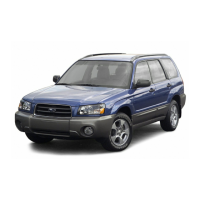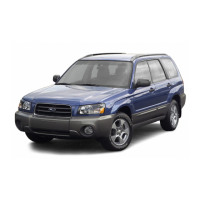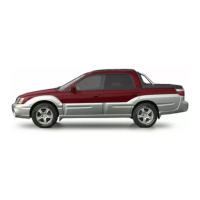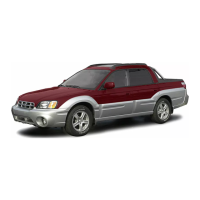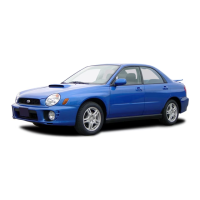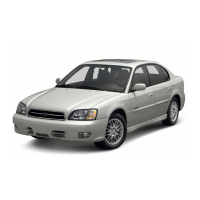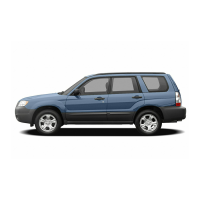Do you have a question about the Subaru 2003 Forester and is the answer not in the manual?
Adjusting front seats for comfort and safety.
Proper use, safety tips, and maintenance of seatbelts.
Guidelines for safely installing and using child restraint systems.
Information on SRS airbag system operation and precautions.
Types of keys, key number, and their functions.
Operation of door locks from inside and outside.
How to use the remote keyless entry system functions.
Operation, arming, and disarming the vehicle's security system.
Operation of power windows and child safety locks.
Operation and features of the moonroof system.
Explanation of ignition switch positions and starting the engine.
Details on speedometer, odometer, fuel, temp, and ambient temp gauges.
Explanation of various warning and indicator lights on the dashboard.
Operation of headlights and other external lights.
Operation of windshield wipers and washers.
Adjustment and features of interior and exterior mirrors.
Operation of the manual climate control panel and its functions.
Features and operation of the automatic climate control system.
Advice for efficient use of the HVAC system in various conditions.
Recommended service intervals for vehicle maintenance.
Procedures for checking and changing engine oil and filter.
Maintenance of the cooling system, including coolant checks.
Information on tire types, inspection, pressure, rotation, and replacement.
Battery safety precautions, charging, and maintenance.
Location and replacement procedures for vehicle fuses.
Guide to replacing various vehicle bulbs.
Fuel requirements, octane rating, and types of gasoline.
Procedures for starting the engine in different conditions.
Explanation of automatic transmission operation and selector lever positions.
Braking tips, system description, and booster function.
How the ABS system works and its warning light.
Instructions for setting, canceling, and operating cruise control.
Break-in procedures for new vehicles to ensure longevity.
Suggestions for improving fuel efficiency.
Precautions and tips for driving in cold weather.
Guidelines for safely loading cargo and adhering to weight limits.
Advice for safe trailer towing, including weight and handling.
Key exterior dimensions of the vehicle.
Specifications related to the vehicle's engine.
List of vehicle fluid capacities.
Tire size and pressure specifications for different load conditions.
Detailed information on fuse box locations and circuits.
Chart detailing bulb types and wattages for various lights.
Explanation of tire grading for treadwear, traction, and temperature.
Procedures for reporting vehicle safety defects to NHTSA.
Adjusting front seats for comfort and safety.
Proper use, safety tips, and maintenance of seatbelts.
Guidelines for safely installing and using child restraint systems.
Information on SRS airbag system operation and precautions.
Types of keys, key number, and their functions.
Operation of door locks from inside and outside.
How to use the remote keyless entry system functions.
Operation, arming, and disarming the vehicle's security system.
Operation of power windows and child safety locks.
Operation and features of the moonroof system.
Explanation of ignition switch positions and starting the engine.
Details on speedometer, odometer, fuel, temp, and ambient temp gauges.
Explanation of various warning and indicator lights on the dashboard.
Operation of headlights and other external lights.
Operation of windshield wipers and washers.
Adjustment and features of interior and exterior mirrors.
Operation of the manual climate control panel and its functions.
Features and operation of the automatic climate control system.
Advice for efficient use of the HVAC system in various conditions.
Recommended service intervals for vehicle maintenance.
Procedures for checking and changing engine oil and filter.
Maintenance of the cooling system, including coolant checks.
Information on tire types, inspection, pressure, rotation, and replacement.
Battery safety precautions, charging, and maintenance.
Location and replacement procedures for vehicle fuses.
Guide to replacing various vehicle bulbs.
Fuel requirements, octane rating, and types of gasoline.
Procedures for starting the engine in different conditions.
Explanation of automatic transmission operation and selector lever positions.
Braking tips, system description, and booster function.
How the ABS system works and its warning light.
Instructions for setting, canceling, and operating cruise control.
Break-in procedures for new vehicles to ensure longevity.
Suggestions for improving fuel efficiency.
Precautions and tips for driving in cold weather.
Guidelines for safely loading cargo and adhering to weight limits.
Advice for safe trailer towing, including weight and handling.
Key exterior dimensions of the vehicle.
Specifications related to the vehicle's engine.
List of vehicle fluid capacities.
Tire size and pressure specifications for different load conditions.
Detailed information on fuse box locations and circuits.
Chart detailing bulb types and wattages for various lights.
Explanation of tire grading for treadwear, traction, and temperature.
Procedures for reporting vehicle safety defects to NHTSA.
| Brand | Subaru |
|---|---|
| Model | 2003 Forester |
| Category | Automobile |
| Language | English |
